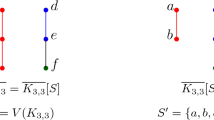Abstract
Circular coloring is a popular branch of graph theory which has been exhaustively studied for two decades mainly from a theoretical perspective. Since it is a refinement of the traditional proper coloring, it provides a more accurate model for cyclic scheduling problems which often arise in industrial applications. The present paper briefly surveys a special class of open shop scheduling that can be solved via circular coloring, and then proposes a new mathematical programming model and tabu search algorithm to compute the circular chromatic number of a graph effectively.


Similar content being viewed by others
Notes
Depending on the vertex order under consideration, the number of essential constraints may be smaller: if \(v_i^k\) and \(v_j^{k+1}\) are adjacent then the corresponding line of (2) automatically follows from that of (5); and if \(j,k,l,m\) are four distinct indices such that \(v_jv_k,v_lv_m\in E(G)\) and both of \(v_j,v_k\) precede both of \(v_l,v_m\) then only (5) is necessary for them. The same simplification applies in the situation where \(v_k\) and \(v_l\) coincide. As a consequence, each vertex has to be involved in at most two constraints of type (5)–(6).
References
Asanovic K et al (2009) A view of the parallel computing landscape. Commun ACM 52:56–67
Brandes U, Eiglsperger M, Herman I, Himsolt M, Marshall MS (2002) GraphML progress report structural layer proposal. In: Mutzel P, Junger M, Leipert S (eds) Graph drawing. Springer, Berlin, Heidelberg, pp 501–512
Coin-OR Cbc. https://projects.coin-or.org/Cbc
Webpage of Brendan McKay. http://cs.anu.edu.au/bdm/data/graphs.html
Dagum L, Menon R (1998) OpenMP: an industry standard API for shared-memory programming. IEEE Comput Sci Eng 5:46–55
Deuber W, Zhu X (1996) Circular coloring of weighted graphs. J Graph Theor 23:365–376
Ernst AT, Jiang H, Krishnamoorthy M, Sier D (2004) Staff scheduling and rostering: a review of applications, methods and models. Eur J Oper Res 153:3–27
Ghebleh M (2007) Theorems and computations in circular colourings of graphs. PhD Thesis, Simon Fraser University
Glover F (1989) Tabu search—part I. ORSA J Comput 1:190–206
Glover F (1990) Tabu search—part II. ORSA J Comput 2:4–32
Guichard DR (1993) Acyclic graph coloring and the complexity of the star chromatic number. J Graph Theor 17:129–134
Hatami H, Tusserkani R (2004) On the complexity of the circular chromatic number. J Graph Theor 47: 226–230
Hertz A, Werra D (1987) Using tabu search techniques for graph coloring. Computing 39:345–351
Kemnitz A, Wellmann P (2004) Circular chromatic numbers of certain planar graphs and small graphs. Congr Numer 169:199–209
Kubale M (2004) Graph colorings. American Mathematical Society, Providence, Rhode Island
Levner E, Kats V, de Pablo D, Cheng TCE (2010) Complexity of cyclic scheduling problems: a state-of-the-art survey. Comput Ind Eng 59:352–361
Maros I (2003) Computational techniques of the simplex method. Kluwer Academic Publishers, Boston
Marx D (2004) Graph colouring problems and their applications in scheduling. Period Polytech Ser El Eng 48:11–16
Modarres M, Ghandehari M (2008) Applying circular coloring to open shop scheduling. Sci Iran 15:652–660
Pardalos PM, Mavridou T, Xue J (1999) The graph coloring problem: a bibliographic survey. In: Du DZ, Pardalos PM (eds) Handbook of combinatorial optimization. Springer, US, pp 1077–1141
Pinedo M (2005) Planning and scheduling in manufacturing and services, vol 24. Springer, New York
Randall, M., Abramson, D.: (1999) A general parallel tabu search algorithm for combinatorial optimisation problems. In: Proceedings of 1999 parallel and real time conference, Melbourne, pp 68–79
Stadtler H (2005) Supply chain management and advanced planning—basics, overview and challenges. Eur J Oper Res 163:575–588
Truszczyński M, Zs Tuza (1992) Rado’s selection principle: applications to binary relations, graph and hypergraph colorings and partially ordered sets. Discret Math 103:301–312
Vince A (1988) Star chromatic number. J Graph Theor 12:551–559
Yeh HG, Zhu X (2005) Resource-sharing system scheduling and circular chromatic number. Theor Comput Sci 332:447–460
Zhu X (1992) Star chromatic numbers and products of graphs. J Graph Theor 16:557–569
Zhu X (2001) Circular chromatic number: a survey. Discret Math 229:371–410
Zhu X, Thomas R (2006) Recent developments in circular colouring of graphs. In: Klazar M, Kratochvil J, Loebl M, Thomas R, Valtr P (eds) Topics in discrete mathematics. Springer, Berlin, Heidelberg, pp 497–550
Acknowledgments
Research of the second author was supported in part by the Hungarian Scientific Research Fund, OTKA grant 81493.
Author information
Authors and Affiliations
Corresponding author
Rights and permissions
About this article
Cite this article
Barany, M., Tuza, Z. Circular coloring of graphs via linear programming and tabu search. Cent Eur J Oper Res 23, 833–848 (2015). https://doi.org/10.1007/s10100-014-0345-8
Published:
Issue Date:
DOI: https://doi.org/10.1007/s10100-014-0345-8




